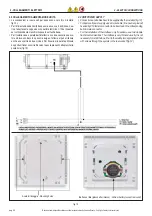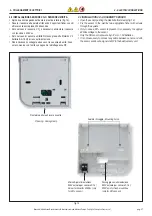
Anomalia
1) La portata aria è inferiore
a quella nominale
2) La portata aria è superiore
a quella nominale
3) La resa termica è inferiore
a quella attesa
4) Formazione e permanenza
di condensa all’interno
della macchina
Probabile causa
Filtri sporchi
Resistenza aeraulica esterna
eccessiva
Serrande di taratura chiuse
Set point velocità di rotazione
ventilatore basso
Mancanza di componenti in-
terni (filtri?)
Pannelli ispezione aperti
Resistenza aeraulica inferiore
al previsto
Portata aria insufficiente
La batterie di pre-riscalda-
mento non funziona (se pre-
sente)
Sifoni inadeguati o mancanti
Possibile soluzione
Pulire o sostituire i filtri
Verificare progetto/impianto
Aprire le serrande e provve-
dere alla taratura di impianto
Elevare il set point da pan-
nello di comando
Montare i filtri (ad unità
spenta)
Chiudere i pannelli
Ridurre il set point di regola-
zione della velocità ventilatori
Vedere anomalia 1
Verificare il collegamento tra
pre-riscaldatore e quadro elet-
trico
Installare sifoni correttamente
dimensionati
Failure
1) Airflow rate is lower than
duty one
2) Airflow rate is higher than
duty one
3) Heating capacity is lower
than expected
4) Water condensate not di-
scharged
Possible reason
Air filter(s) dirty
Plant air resistance higher
than expected
Adjusting dampers closed
Fans speed setpoint too low
Internal component missing
(filter ?)
Access panels open
Plant air resistance lower than
expected
Not enough air flow rate
Pre-heater does not operating
(if present)
Syphon wrong or missing
What to do
Clean or replace air filter(s)
Check air plant project
Open the dampers and ba-
lance the plant
Increase setpoint by control
panel
Install the missing component
(while unit is off)
Close the access panels
Balance the air plant
by dampers
Check plant project
Reduce fan speed setpoint
(See failure 1)
Check connection between
pre-heater and controller
Install well-sized syphon
7 - GESTIONE ANOMALIE DI IMPIANTO
7 - TROUBLESHOOTING
7.1 GUIDA RICERCA GUASTI
7.1 TROBLESHOOTING GUIDE
8 - SMALTIMENTO
8 - DISPOSAL
Il simbolo indica che questo prodotto non deve essere smaltito come
rifiuto urbano misto e che per esso va praticata una raccolta differen-
ziata, in base alle leggi e normative locali.
Contattare le autorità locali per avere informazioni sulle possibilità di
smaltimento.
All’atto dell’acquisto di una nuova apparecchiatura, equivalente a quella
da smaltire, quest’ultima può essere consegnata al distributore che ne
effettuerà il ritiro a titolo gratuito.
I materiali che compongono i recuperatori di calore serie sono:
• Lamiera preverniciata
• Lamiera zincata
• Alluminio
• Rame
• Polipropilene
• Polistirene
Manuale di Installazione e Manutenzione unità di recupero calore ad altissima efficienza -
Very high efficiency heat recovery unit
pag. 40
This symbol indicates that this product must not be disposed of with
household waste. Dispose of the unit properly according to local laws
and regulations.
When the unit reaches the end of its useful life, contact the authorities
for information on disposal and recycling possibilities.
Upon buying of a new unit, corresponding to the one to be disposed of,
this last one could be given to the supplier, who will pick it up free of
charge.
The materials making up the series heat recovery units are:
• Precoated steel sheet
• Galvanized steel sheet
• Aluminium
• Copper
• Polypropylene
• Polystyrene




































